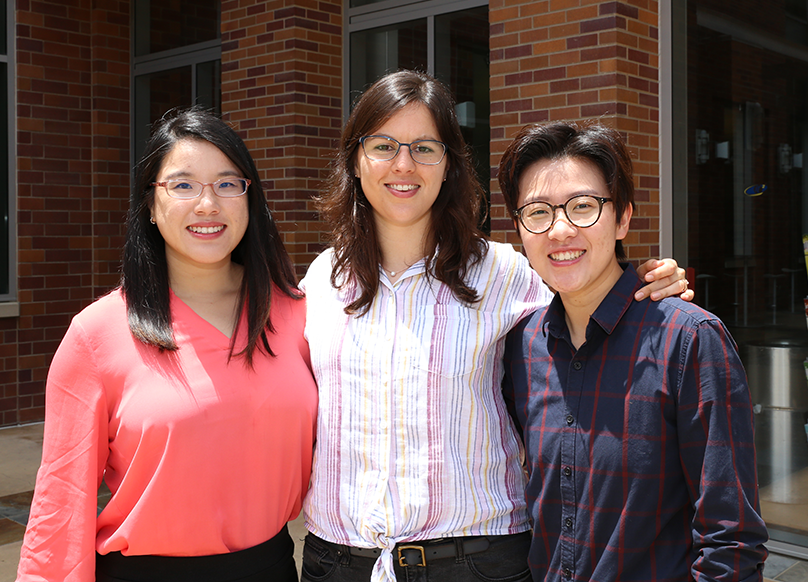NSF, CADMIM Fund Graduate Student Internships

Lin, Herrera and Chen (from left) say they gained valuable skills by participating in internships at local companies during their doctoral studies.
June 25, 2019 -Thanks to help from the National Science Foundation and UC Irvine’s Center for Advanced Design and Manufacturing of Integrated Microfluidics (CADMIM), three Samueli School graduate students added industry experience to their already stellar academic careers with internships in local companies.
The Non-academic Research Internships for Graduate Students Supplemental Funding allowed Lancy Lin, Esther Chen and Vanessa Herrera to spend up to six months in company internships as they completed their doctoral degrees.
Lin and Herrera were both students in the Department of Biomedical Engineering, while Chen was a chemical engineering graduate student. All three have graduated, or will graduate, this year with their Ph.D. degrees.
Lin and Chen worked for six months at Beckman Coulter, where they investigated existing Beckman product lines.
Lin sought ways to innovate hematology analyzers, the large blood-testing instruments found in hospitals and laboratories. Specifically, she was charged with determining whether customers would be interested in purchasing these instruments if and when specific new innovations were included.
Lin, whose adviser is biomedical engineering professor Michelle Khine, focuses her Ph.D. research on wearable health sensors, bandage-like sensors that adhere to the skin and can record vital signs like breathing, heart rate and blood pressure. She worked to create a system of these sensors for early detection and disease management for those at risk for or diagnosed with heart failure.
“Ph.D. students are often asked whether they plan to pursue academic research or industry research after graduation. A great way to answer this question is to experience both prospects,” Lin says. “The industry internship was valuable to me because I experienced a position catered to candidates with doctoral degrees, specifically using the experimental design and research skills that veteran researchers would possess.”
Lin, who plans to pursue industry research or entrepreneurial opportunities, adds that the business-level classes she had access to as a Beckman intern were helpful both as resume-builders and specifically in gathering feedback about her prototype health sensor. “I strongly believe those skills played a central role in helping us win a student design competition,” she says.
Chen, whose adviser was Wendy Liu, associate professor of biomedical engineering, did doctoral research that sought to fabricate immunomodulatory materials for tissue engineering and drug delivery. At Beckman Coulter, she worked on a cross-functional and multidisciplinary team to identify unmet clinical needs. Her responsibilities included market analysis and identifying trends that could inform decisions about new product development.
She echoes Lin’s sentiments about the value of the internship experience. “One of the questions a Ph.D. student will have is whether to stay in academia or go into industry,” Chen says. “This internship provides a really good opportunity for us to understand the dynamics of industry, how this works and whether [that] is something we are looking for.”
Chen also traveled to Denmark and Sweden for a meeting with Beckman associates. “That was definitely not some normal experience that a student would get – sitting in a meeting room with executive level leaders from different countries to talk about technology and potential collaboration,” she says.
Because of this internship, Chen adds, she is leaning toward a career in industry, where she can apply her scientific knowledge to business innovation.
Herrera, who was advised by biomedical engineering assistant professor Jered Haun, is working at Amgen. Her internship, which ends this month, involves developing single-cell assays using an optofluidic cell selection and manipulation platform called Beacon. The work dovetails nicely with her doctoral research, in which she develops detection assays using nanoparticles and imaging to quantify proteins secreted from single cells.
She says her experience at Amgen was valuable for several reasons, including her exposure to industry-specific responsibilities. She cites analyzing and interpreting data into meaningful outcomes, working in state-of-the-art research facilities and understanding FDA regulations and documentation in an industry setting. “This internship helped me advance in my career since it taught me the skills I need to have a successful transition into industry research,” says Herrera, who hopes to work in the pharmaceutical industry as a research and development scientist.
The NSF funding that supported the three students was a supplemental grant to CADMIM’s existing NSF grants. NSF’s goal is to foster the growth of a globally competitive and diverse research workforce and to advance the scientific and innovation skills of the nation.
- Anna Lynn Spitzer
